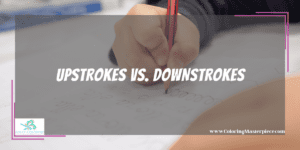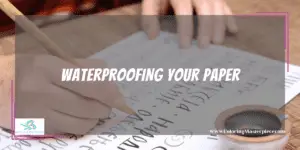Calligraphy is an art form centered around creating elaborate lettering. It is traditionally done with a dipped ink pen, but that doesn’t mean that other more approachable forms aren’t available. Pencil calligraphy is not only cost-effective but also less messy than other forms of calligraphy.
Upstrokes vs. Downstrokes

You’ve invariably noticed with traditional ink dip calligraphy that certain lines are thicker than others. It is possible to achieve this with a pencil as well. The lines that go in a downward direction as you’re drawing will be thicker than those you make in an upward direction. This can be enhanced by the pressure you apply to the pencil during these strokes. Apply more pressure when going down for thick lines and apply less pressure when moving your pencil up to get a wispy yet clearly defined line.
Keep in mind that a sharpened pencil is a bad idea when doing calligraphy. You’ll want to use a duller pencil as the pencil tip may crumble as you do a downward stroke with more pressure, and the thin exacting lines provided by a sharpened pencil will not give you the flow and continuity you’re looking for in the whimsical calligraphy style. If your pencil needs to be sharpened, soften the tip of the pencil by rubbing the tip around on a piece of scratch paper before you begin your lettering.
Make sure you’re paying close attention to the spacing between letters. A powerful downstroke may blur the letters together, making what you’re writing illegible or clunky-looking. Since calligraphy is designed to be beautiful, symmetry is a key component you need to keep in the forefront of your mind as you dive into this art form.
One of the fabulous things about pencil calligraphy is you can draw in thicker downstrokes by creating two lines that you can later color in so that the downstroke seems super thick. This creates an even bolder contrast and opportunity for really fantastical designs because it allows you to embolden letters in a way that just can’t be achieved by a normal pencil tip.
Types of Pencils to Use
When choosing the pencil you’re going to use as you begin your calligraphy journey, it’s good to remember that not all pencils are created equally. You’ll want to choose a pencil that is graded 2B, HB, or B because its graphite core is soft. You can hold the pencil as you normally would, which is a big advantage to traditional calligraphy where the pen or brush must be held at the bottom when creating brush strokes. Pencils that are too hard will not show up on an upstroke, which can be frustrating when dipping your toes into the calligraphy style of writing.
A carpenter’s pencil, which can be found at any hardware store, is a great tool choice for the beginning calligrapher because the lead is so thick and the pencil is so easy to grasp. The thick strokes that can be made with its large head will lend well to practice regarding pressure as you write. These pencils are easily sharpened with a knife since they don’t fit into a common pencil sharpener.
Mechanical pencils are not recommended. This is because the line strokes you make are harder to control through pressure due to how most mechanical pencils are structured. Mechanical pencils are usually designed to create a uniform stroke regardless of how light-handed or heavy-handed the drawer is, and this will not serve you well with the art of calligraphy.
No matter what tool you’re using when doing calligraphy, it’s important to remember that any upward motion you make is going to appear lighter than any line you make going in a downward direction. Don’t forget about the magic you can create with colored pencils. Not only can you create elaborate lettering, but you can also do so with color. This will add a whole new dimension to your work that you can’t achieve with ink.
Let’s learn about using watercolor pens for calligraphy!
Faux Calligraphy
Many artists who are teaching students about calligraphy basics suggest starting with faux calligraphy. Faux calligraphy involves writing letters on a page as you normally would and going over your writing to embellish what is already on the page. Make sure, when you do the rewrite, that you’re applying more pressure while doing downstrokes than you are when doing upstrokes. This helps differentiate the lines on paper and gives the lettering that fancy feel you’re undoubtedly trying to achieve.
Once you’ve gone over the letters you’ve written normally, experimenting with pencil pressure along the way, try rewriting exactly what you’ve written before while playing with the natural motions you make during a normal writing session. Just accentuate your natural downstrokes elaborate on your usual upstrokes and see where the pencil takes you.
One of the biggest advantages of faux calligraphy is mastering the technique of connecting your letters. Make sure you’re connecting the end of one stroke with the beginning of another stroke as you move between the letters on the page.
The Surface Under Your Calligraphy Page
While doing painting or watercolors, the surface under the page you’re working with isn’t as important as it is when doing pencil calligraphy. If you don’t put a piece of thick paper under the paper you’re writing on, it will appear bumpy as the graphite in the pencil will pick up every bump and groove, especially if you’re writing on a surface covered with a tablecloth.
To pad your main page, use a thick piece of drawing paper or watercolor paper as a barrier between your project and the area that is your workstation. This will save you from the frustration of experiencing patterns within your pencil work that you don’t want.
Waterproofing Your Paper

Pencil lines are prone to smudging, so waterproofing your paper is a great option to avoid this catastrophe. Once you’re done with your work, use a finishing spray on your art to keep the markings you’ve made from smudging during handling. Pencil easily smears, so this is not a step that should be ignored.
You can also use a Vaseline-like substance called microglaze to seal in the pencil calligraphy you’ve created. This is great for works done on the outside of envelopes that may be exposed to the elements during shipment. Just use the tip of your finger to smear the substance over the top of your work to seal it in, taking care not to smudge the writing underneath with too thick of an application or too much fingertip pressure.
Practice Worksheets
Try googling practice worksheets for calligraphy if you’re overwhelmed with how to start the process. These worksheets are cheat sheets, especially for people who aren’t versed in cursive letters but want the flowing nature that comes with that type of writing. Pinterest is another great place to find these worksheets.
These cheat sheets will have very lightly printed letters on them, and a horizontal line extending from the first letter, where you can practice the motions you’re trying to achieve over and over before you commit to your final project. It’s a lot like creating color swaths before a painting project; it allows you to try out different pencils and pressure amounts to determine what exactly you want your final work to look like.
If you don’t have a printer to print these cheat sheets, use a ruler to create lines on a normal piece of paper so you can learn to keep your lettering in a straight line. When you’re feeling confident enough to ditch the cheat sheets but still don’t feel confident enough to do calligraphy without guidance, draw straight lines on another piece of paper that can be seen through your top sheet to keep your lines straight. You’ll get the guidance you’re looking for without applying garish lines to your final project.
You can also print out a sheet in a font you enjoy and put it on top of a light box, which is an illuminated surface designed for artists to see the work underneath for tracing. This will allow you the opportunity to trace the font you’re trying to achieve without having to think much about the placement of line strokes. Light boxes can be pricy, but there are cheap variations available around the internet that plug into a USB port and provide the same effect that more expensive models create.
Conclusion
The biggest thing to remember when starting with pencil calligraphy is that practice is what will make your line work perfect. Practice your basic strokes while applying various pressure to get what you want out of your final piece. It’s important to remember that everyone’s calligraphy will differ as much as different handwriting styles, so find the appearance that best matches your natural handwriting.
Maximize the benefits of coloring with my free adult coloring eBook and by signing up for my email newsletter HERE!
Disclaimer: The information provided by ColoringMasterpiece.com (“The Site”) is for general informational purposes only. All information on the Site is provided in good faith, however, we make no representation or warranty of any kind, express or implied, regarding the accuracy, adequacy, validity, reliability, availability, or completeness of any information on the Site. Under no circumstance shall we have any liability to you for any loss or damage of any kind incurred as a result of the use of the Site or Reliance on any information provided on the Site. Your use of the Site and your reliance on any information on the Site is solely at your own risk. This blog post is for educational purposes only and does not constitute legal advice. Please consult a legal expert to address your specific needs.
Terms and Conditions: https://coloringmasterpiece.com/terms-and-conditions/

